How to grow bougainvillea at home?
Growing bougainvillea at home is not too laborious, although the plant is considered capricious. These profusely flowering climbing shrubs belong to the Noctus family. The genus received this name in honor of the traveler Louis Antoine de Bougainville, the leader of the first French round-the-world expedition.
Types and varieties
Bougainvillea is common in South America; it is found everywhere in parks, squares and decorates residential buildings. Plants are used to decorate walls, columns, pavilions and gazebos, since their care is quite simple. The flowers of these lianas are inconspicuous, small, but the inflorescence leaves of paper texture and various colors are very decorative.
Common types of bougainvillea
- Bougainvillea is wonderful, or beautiful, - often used in landscape design, as it grows quickly, forming "living walls". The bracts gradually fade, creating smooth transitions and giving the bushes a special charm.
- Bougainvillea Peruvian - blooms very long and magnificently, but branches poorly.
- Bougainvillea Butte (a hybrid of naked and Peruvian) is the founder of many modern varieties.
- Bougainvillea is smooth - these vines have glossy leaves and colorful bracts, and are often used to create hybrids.
At home, two types are most often grown: smooth bougainvillea and wonderful. Terry hybrids are very attractive: bouquets of bright bracts, most often purple, completely cover the foliage during flowering.
Several popular varieties of this plant:
- Apple Blossom - white and pink bracts;
- Australian Gold - terry bracts, painted in salmon-orange color;
- Australian Pink - pink bracts, easy maintenance, blooms profusely;
- Double Red - double bracts, purple;
- Glabra Variegata - variegated variety, lilac bracts;
- Mini Thai - bracts are light pink or orange.
Post-purchase bougainvillea care
This shrub is native to Brazil, therefore it is used to sunlight: southern windows suit it best. Home care is simple. Watering the plant needs moderate, but the soil should not dry out completely. After the purchase, for the first three days, the flower pot is shaded a little, then it must be placed on the most lighted area in the house. An adult bougainvillea is capable of withstanding direct sunlight. With a lack of light and nutrition, the bracts turn pale and turn green. To adapt to a new place, the liana will take 2-3 weeks, after which it can be transplanted into another container.
Advice
If bougainvillea is sold as a discounted plant, and the store says that the flower is “disposable” and growing in a room is problematic, there is no need to despair. With good care, achieving multiple blooms at home is not as difficult as it sounds. When purchasing a liana in a deplorable state, you can try to revive it by spraying it with a growth stimulant and covering it with a bag.
Lovers of indoor exotic plants often order cuttings of rare plants by mail, including varietal bougainvillea hybrids. Having received such a package, you need to inspect the flower: if it is dried, the leaves have wilted, you can water it a little, in small portions, then the turgor should be restored. If the soil in the cup is wet, you don't need to do anything. The cuttings are placed in a shaded place for the first few days.
Bougainvillea transplant
It is best to transplant bougainvillea at home using the transshipment method.Its roots are very delicate and brittle, and if damaged, the leaves and bracts of the plant will begin to crumble, and the cuttings may die. If the bush is watered in advance, then it will be easier to free the earthen lump from the old container. Growing a vine in a pot that is too large increases the risk of flooding and negatively affects its growth and flowering. If transplanting is required for an adult plant, the new container should be 2-3 cm wider than the previous one. For the cutting, you need to take a small glass, slightly exceeding the volume of the root system.
Advice
A cramped pot has a positive effect on flowering vines at home. When transplanting, it is undesirable to deepen the root collar - it can rot. Young bougainvilleas are transplanted every spring, adults - every 3-4 years. If the plant is in transport soil, shake it off a little, being careful not to damage the roots. It happens that young bushes or rooted cuttings are in a net that remains from peat tablets, - it must be removed.
At the bottom of the container, you need to put a thick layer of drainage, it is advisable to use foam for this purpose, but expanded clay is also suitable. They take a nutritious substrate, you can make it yourself by mixing the same parts of sand, vermiculite, sod and leafy soil. Bougainvillea loves a neutral or slightly acidic substrate, with a pH of 6.8-7. You can add several superphosphate granules to it. The next feeding is not earlier than 3 weeks after transplantation. If you lose turgor, you can spray the vine with a growth stimulant and cover with a bag for 2-3 days, periodically removing it for a few minutes.
Growing at home
Caring for bougainvillea in the summer consists in regular watering with warm water (about + 35 ° C) and top dressing. An adult plant blooms at home all spring and autumn. In summer, it can be taken out into the garden, in direct sunlight, and left there until autumn. The flower is fed from March to April - once every 7-10 days with complex mineral fertilizers, and from May to August you need to use a composition where there is more phosphorus and potassium.
Advice
If bougainvillea does not bloom even after proper wintering, its leaves turn yellow and fall off, and care seems optimal, it is necessary to reduce watering.
In autumn or early spring, the branches should be pruned to stimulate flowering. But it should be remembered that you can only shorten the stems in bushes up to three years of age. Plants grown from cuttings usually flower in the second year. Bougainvillea loves spraying and is bad for drafts.
Winter care when growing bougainvillea at home is to provide a dormant period. Only he can complicate the cultivation of this vine. For wintering, choose a cool and bright place where the temperature is about 10-15 ° C, for example, a glazed balcony. Some varieties of these shrubs tolerate a short-term drop in temperature to 0 ° C. Watering in winter is reduced, but the earthen coma should not be allowed to dry out.
Reproduction of bougainvillea
The best time to breed bougainvillea at home is late spring. Most often, cuttings are used, for which they take semi-lignified shoots obtained during pruning, about 8 cm long. They are placed in warm water for several hours, then in a root formation stimulator. The cuttings are planted in moist soil, which you can prepare yourself by mixing peat, coal, finely chopped sphagnum and sand. Another option: soil consisting of sod land, leaf humus, sand and peat in a ratio of 2: 2: 1: 1.
After planting, the cuttings require special care: they are placed in a greenhouse, which must be regularly ventilated. It is removed only when the plant starts growing. The temperature for successful rooting should be at least + 26 ° C. Bottom heating and additional lighting can be used. It is very important to carefully transplant the cutting when it takes root.Even if the roots are completely entwined with an earthen ball, they can be easily damaged or broken off. It is better not to pull the bougainvillea by the trunk, but to cut the container in which it is located.
Diseases and pests
This vine is rarely damaged by pests, but sometimes it is attacked by a mealybug, aphid or spider mite. Against them, you can use folk remedies (infusion of garlic, ash, green soap) or you can immediately purchase special preparations. To prevent a tick, you can try this method: spray the plant once a week with warm water with the addition of any essential oil (10 drops per 1.5 l).
Bougainvillea can get chlorosis and the leaves will lose color. It can be caused by a lack of nutrients such as iron. Then you need to increase the dose of fertilizers and spray the flower with iron chelate. When an earthen coma is waterlogged, the plant can be susceptible to fungal diseases. You can save the bush by drying the soil and treating it with a fungicide.
Output
Caring for this plant is simple: it consists in regular moderate watering and feeding. A dormant period in winter and formative pruning are required for budding. When transplanting, you must try not to damage the root system.
Growing bougainvillea at home can be overshadowed by diseases of this plant. It should be remembered that proper care of the vine strengthens its immunity and helps to resist diseases and pests. A little care - and this unusual bush will delight its owners with abundant flowering.
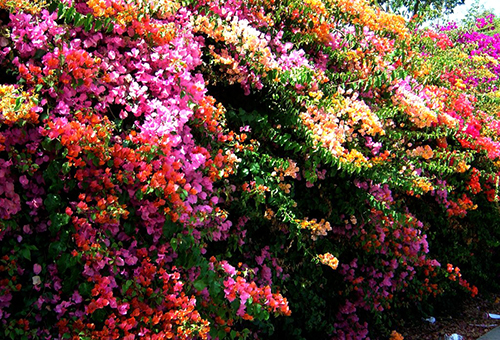
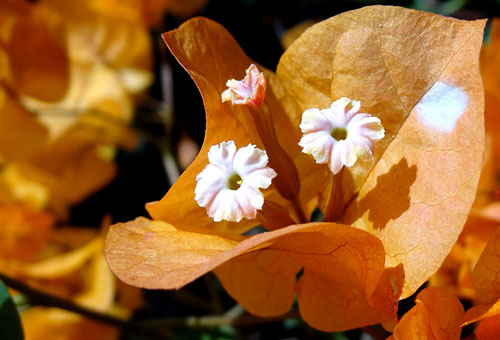
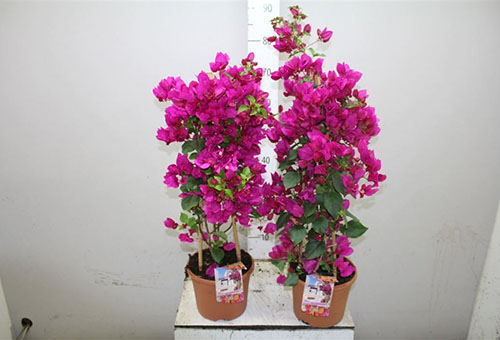
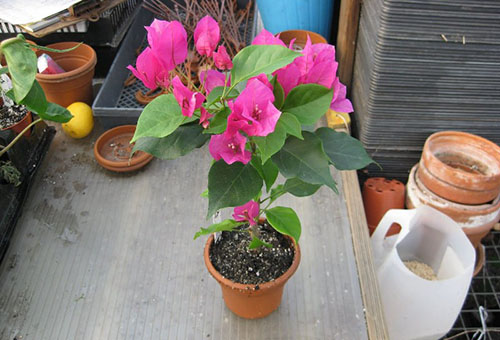
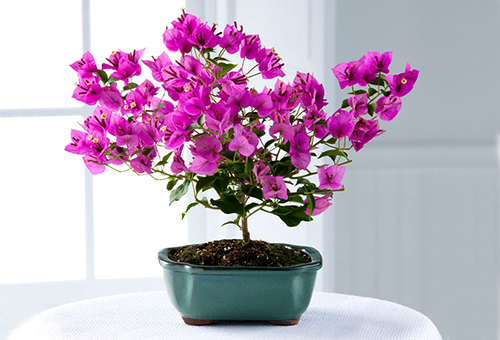
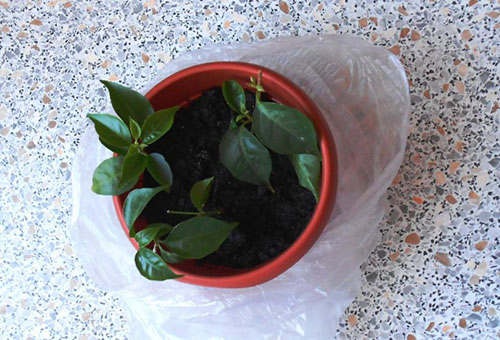
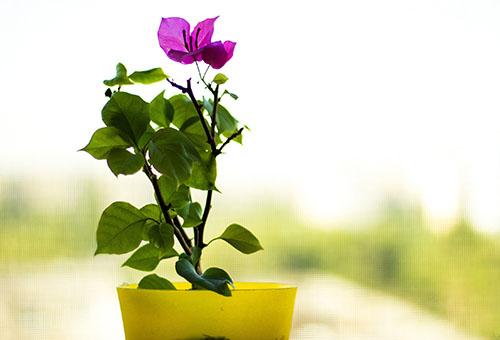
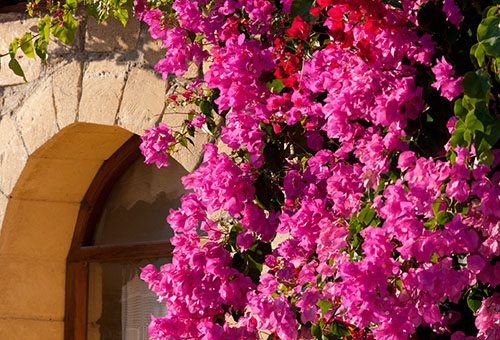
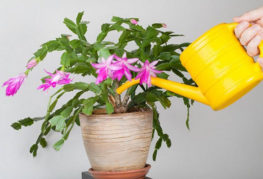
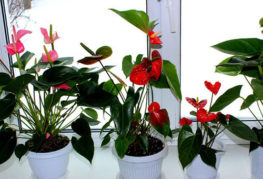
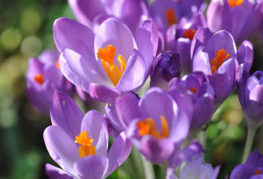
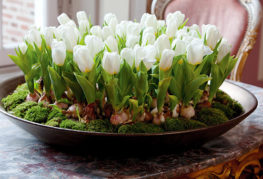
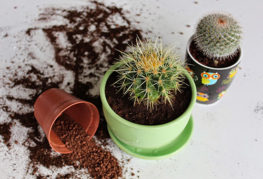
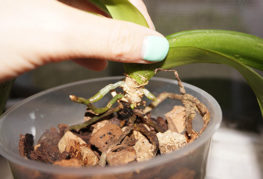
and will be published shortly.